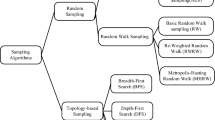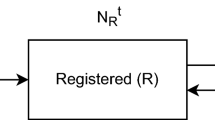Abstract
With the increasing popularity of social networks, it is becoming more and more crucial for the decision makers to analyze and understand the evolution of these networks to identify for example, potential business opportunities. Unfortunately, understanding social networks, which are typically complex and dynamic, is not an easy task. In this paper, we propose an effective and practical approach for simulating social networks. We first develop a social network model that considers growth and connection mechanisms (including addition and deletion) of social networks. We consider the nodes’ in-degree, inter-nodes’ close degree which indicates how close the nodes are in the social network, which is limited by the in-degree threshold. We then develop a graph-based stratified random sampling algorithm for generating an initial network. To obtain the snapshots of a social network of the past, current and the future, we further develop a close degree algorithm and a close degree of estimation algorithm. The degree distribution of our model follows a power-law distribution with a “fat-tail”. Experimental results using real-life social networks show the effectiveness of our proposed simulation method.
















Similar content being viewed by others
References
Abdi H, Williams LJ (2010) Principal component analysis. Wiley Interdiscip Rev Comput Stat 2:433–459
Albert R, BarabJasi A-L (2002) Statistical mechanics of complex networks. Rev Mod Phys 74:47–97
Barabasi A-L, Albert R (1999) Emergence of scaling in random networks. Science 286(15):509
Barabási A-L, Albert R, Jeong H (1999) Mean-field theory for scale free random networks. Phys A 272:173–187
Basso K, Margolin AA, Stolovitzky G et al (2005) Reverse engineering of regulatory networks in human B cells. Nat Genet 37(4):382–390
Bates JM, Granger CWJ (1969) The combination of forecast. Op Res Q 20:451–468
Bianconi G, Barabási AL (2001) Competition and multiscaling in evolving networks. EPL 54(4):436–440
Boyd CR, Tolson MA, Copes WS (1987) Evaluating trauma care: the TRISS method. Trauma score and the injury severity score. J Trauma 27(4):370–378
Bunn DWJ (1989) Forecasting with one model. Forecasting 8(3):162–166
Carlson JM, Doyle J (1999) Highly optimized tolerance: a mechanism for power laws in designed systems. Phys Rev E 60(2):1412–1427
Che H, Gu J (2004) Cale-free network and system scientific significance. Syst Eng Theory Pract 4:11–16
Chen K, Guo S (2010) Least absolute relative error estimation programme. J Am Stat Assoc 105(491):1104–1112
Chow T (1997) The Q-spectrum and spanning trees of tensor products of bipartite graphs. Proc Am Math Soc 125:3155–3161
Cooper C, Frieze A, Vera J (2004) Random deletion in a scale-free random graph process. Internet Math 1(4):463–483
D’Angelo G, Ferretti S (2009) Simulation of scale-free networks. Belgium, ICST, 21
Deo N, Cami A (2007) Preferential deletion in dynamic models of web-like networks. Inf Process Lett 102:156–162
Dorogovtsev SN, Mendes JFF (2000) Scaling behaviour of developing and decaying networks. Europhys Lett 52(1):33–39
Dorogovtsev SN, Mendes JFF, Samukhin AN (2000) Structure of growing networks with preferential linking. Phys Rev Lett 85:4633–4636
Fabrikant A, Koutsoupias E, Papadimitriou CH (2002) Heuristically optimized trade-offs: a new paradigm for power laws in the Internet. In Proceedings of the International Colloquium on Automata, Languages and Programming. Springer, pp 110–122
Feder T, Motwani R (1991) Clique partitions, graph compression and speeding-up algorithms. J Comp Sys Sci:123–133
Goel S, Salganik MJ (2009) Respondent-driven sampling as markov chain monte carlo. Stat Med 28:2202
Hubler C, Kriegel HP, Borgwardt K, Ghahramani Z (2008) Metropolis algorithms for representative subgraph sampling. Proceedings of ICDM08, 283–292
Jeong H, Tombor B, Albert R, Oltvai ZN, Barabási AL (2000) The large-scale organization of metabolic networks. Nature 407(6804):651–654
Leskovec J, Faloutsos C (2007) Scalable modelling of real graphs using kronecker multiplication. Proceedings of the 24 th International Conference
Leskovec J, Chakrabarti D, Kleinberg J, Faloutsos C (2005) Realistic, mathematically tractable graph generation and evolution, using kronecker multiplication. http://www.cs.cmu.edu/~jure/pubs/kronecker-pkdd05.pdf
Liben-Nowell D, Kleinberg J (2007) The link-prediction problem for social networks. Am Soc Inf Sci Technol 58(7):1019–1031
Metropolis N, Rosenbluth AW, Rosenbluth MN, Teller AH, Teller E (1953) Equation of state calculations by fast computing machines. J Chem Phys 21(6):1087–1092
Mitzenmacher M (2001) A brief history of lognormal and power law distributions. In Proceedings of the Allerton Conference on Communication, Control, and Computing, pp 182–191
Newman MEJ (2003) The structure and function of complex networks. SIAM Rev 45:167–256
Novikov E, Barillot E (2008) Regulatory network reconstruction using an integral additive model with flexible kernel functions. Bmc Syst Biol 2:8
Pollner P, Palla G, Vicsek T (2006) Preferential attachment of communities: the same principle, but a higher level. Europhys Lett 73(3):478–484
Ren W, Li J (2009) A fast algorithm from simulating scale-free networks, Proceedings of ICCT
Sabder J, Ester M, Kriegel HP, Xiaowei X (1998) Density-based clusteringin spatial databases: the algorithm GDBSCAN and its applications. Data Min Knowl Disc 2(2):169–194
Sarshar N, Roychowdhury V (2004) Scale-free and stable structures in complex ad hoc networks. Phys Rev E 69(2):357–368
Squicciarini A, Rajasekaran SD, Mont MC (2011) Using modeling and simulation to evaluate enterprises’ risk exposure to social networks. IEEE Comput 44(1):66–73
SK Hacker, JT Israel (1999) Building trust key customer-supplier relationship. The performance center and satisfaction strategies
Toivonen R, Onnela JP (2006) A model for social networks. Phys A 371:851–860
Winters PR (1960) Forecasting sales by exponentially weighted moving averages. Manag Sci 6(3):324–342
Yu J, Smith VA, Wang PP et al (2004) Advances to Bayesian network inference for generating causal networks from observational biological data. Bioinformatics 20(18):3594–3603
Author information
Authors and Affiliations
Corresponding author
Rights and permissions
About this article
Cite this article
Zeng, R., Sheng, Q.Z. & Yao, L. A simulation method for social networks. Soc. Netw. Anal. Min. 5, 6 (2015). https://doi.org/10.1007/s13278-015-0246-4
Received:
Revised:
Accepted:
Published:
DOI: https://doi.org/10.1007/s13278-015-0246-4




